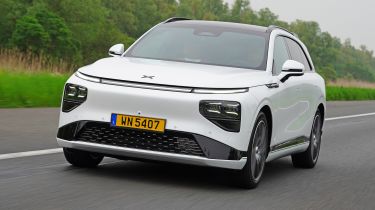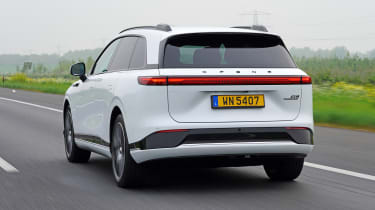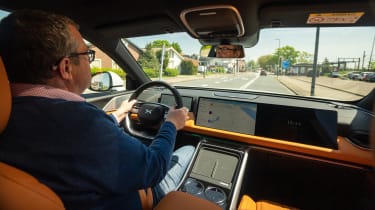New XPeng G9 2023 review
We think the Xpeng G9 would be a worthy addition to the UK's electric car market
Verdict
It’s not exactly bursting with dynamic sparkle, and we’d probably forego the extra motor of this Performance version, but the XPeng G9 is still one of the most impressive all-electric SUVs we’ve tried recently. It has plenty of space and oodles of in-car tech, is really well finished, and has the performance, range and charging speeds to go head to head with rivals from Korea, Germany or even California. All it really needs is XPeng to commit to making it in right-hand drive and get on with establishing a dealer network here. The car is ready to find UK customers, we’d argue.
Chinese brands are racing towards Europe right now, and many have the UK in their sights. We’ve already seen the impact that the likes of the revitalised MG and newcomers BYD and Ora can have – and Shanghai company XPeng is hoping that it can tap into the burgeoning market for EVs in the region too. The G9 flagship SUV would be an obvious candidate for UK showrooms, and this is our first chance to see how it stacks up, albeit in very late pre-production form and on Dutch roads.
We were pretty impressed with the packaging, look and feel of the G9 when we saw it at a static presentation earlier at the start of this year. To recap, it’s a 4.8-metre-long, five-seat SUV that’s slightly longer, both overall and in wheelbase, than the likes of the BMW X3. It sits on XPeng’s own bespoke EV architecture, charmingly called Edward, and comes in three configurations, starting with a smaller-battery edition with a single rear motor producing 308bhp and a 75kWh LFP-chemistry pack delivering 286 miles of range.
Used - available now

2022 Peugeot
E-2008
17,336 milesAutomaticElectric
Cash £13,400
2021 Peugeot
2008
9,432 milesManualPetrol1.2L
Cash £15,100
2023 Jaguar
I-PACE
23,066 milesAutomaticElectric
Cash £21,697
2024 Kia
Stonic
18,073 milesAutomaticPetrol1.0L
Cash £15,002There are then two extended-range versions, which have more energy-dense NMC chemistry and 93kWh (net) capacities. One has the same rear-drive set-up as the Standard Range, and manages up to 354 miles on a single charge; the other gets an extra motor for a combined output of 543bhp – enough for a 0-62mph time of 3.9 seconds – but sacrifices a little range in the name of performance, at 323 miles.
XPeng is making bold claims on charging, too. The smaller-battery edition can manage DC rates of up to 260kW but the 93kWh models crank this up to 300kW – enough, XPeng says, for the car to add 60 miles of range in just five minutes when hooked up to a fast enough charging point.
The range offering is refreshingly simple, too. All cars get a heat pump, a full-length panoramic glass roof, heated and ventilated front seats, heated rear seats, a heated steering wheel and soft-close doors as standard. There’s no word yet on UK pricing – XPeng is still working on the business plan for right-hand drive, it says, even though the smart money is on a debut here in late 2024 or early 2025 – but the car has already been launched in the Netherlands, with prices ranging from around £51,000 to £62,500.
Climbing aboard, those numbers seem pretty realistic, because there’s precious little inside the G9 to give away the fact that it’s a vehicle designed and manufactured in China. The materials and finishes are deeply impressive, with neatly stitched leather on the seats and soft-touch finishes in all of the right places. There are metallic elements on the centre console and subtle ambient lighting allows you to personalise the cabin when you’re on the move.
The only ‘tell’ on the car’s origins is its technology, because it arguably has too much. The 10.25-inch digital instrument panel is par for the course but the pin-sharp 14.96-inch central infotainment display is matched by an identical panel designed for the front passenger’s use. It has pixel filtering tech that’s designed to allow a movie to be watched – in a traffic-clogged Shanghai rush hour, you suspect – without the driver’s being distracted by it; in truth, it’s a bit of tech overkill that established European brands would resist.
We’re driving the AWD Performance today and sure enough, it has pretty shocking acceleration for something with the G9’s dimensions, not to mention its 2.3-tonne kerbweight. Indeed, should you select Sport mode for maximum pace, it actually becomes hard to modulate the throttle pedal inputs, such is the car’s desperation to react to the smallest of them. The left-hand pedal can also be a tricky customer, although once you’re through the early part of retardation, and the bleed-off between energy recuperation and the (Brembo) discs and pads is resolved, you’ll find it easy enough to come to a smooth stop in city traffic. There’s also a selectable single-pedal mode that will bring the car down to a really slow creep – again, useful in heavy traffic.
Despite its size, in fact, the G9 is well suited to urban routes. The steering is light and consistently weighted (though devoid of feel, you won’t be surprised to hear), and there’s decent visibility, assisted by a plethora of cameras whose images are relayed to the central screen to help eliminate blind spots. Performance editions get air suspension as standard and it does a good job of soothing out side-street ripples.
It’s accomplished on motorways, too, where the impressive electric-motor refinement mixes with a pretty soothing ride (only troubled by the sharpest and deepest bridge-expansion joints) to ensure a comfortable experience. There’s a bit of low-frequency resonance transmitted up from selected road surfaces but in general, the worst offenders for noise at speed are the chunky side mirrors.
We had precious little opportunity to explore the G9’s limits on roads that mixed speed with tighter corners or camber changes, but the overall set-up would lead us to expect that it may well require a little patience in corners, lest the powertrain overwhelm the tall body and the comfort-focused suspension beneath it.
As for the in-car tech, it’s still undergoing final tweaks – the beauty of software over hardware, we’re told – but there are sensible (non-haptic) switches on the steering wheel that control several key functions, including the cabin temperature, and shortcuts placed on the top of the enormous central screen for features like the windscreen de-mister.
It’s a shame, though, that you still need at least two screen prods to change the vehicle’s driving mode or its level of brake energy recuperation – although XPeng’s voice assistant will have a stab at cutting this out if you’re prepared to talk to it. Apple CarPlay and Android Auto integration are missing, too – not uncommon from Chinese brands, but XPeng ought to realise that European customers are keen on using their phones instead of, for example, built-in navigation.
The G9 is a practical thing, with standard recline on the rear seats (which are heated, remember), bags of legroom for back-seat passengers and a 660-litre boot that expands to 1,576 litres when the 60/40-split second row is folded down. There’s an additional 71-litre frunk beneath the bonnet for cable storage, and XPeng even sells a self-inflating sleep kit that can turn the rear cabin into overnight accommodation.
| Model: |
XPeng G9 AWD Performance |
| Price: |
€71,990 (£62,500) (Netherlands) |
| Powertrain: |
2x e-motor, 93kWh batt. (net) |
| Power/torque: | 543bhp/717Nm |
| Transmission: |
Single-speed automatic, four-wheel drive |
| 0-62mph: | 3.9 seconds |
| Top speed: | 124mph |
| Range: | 323 miles |
| Max charging: |
300kW (10-80% in 20mins) |
| On sale: | 2025 (est.) |
Now read our review of the Nio EL7...












